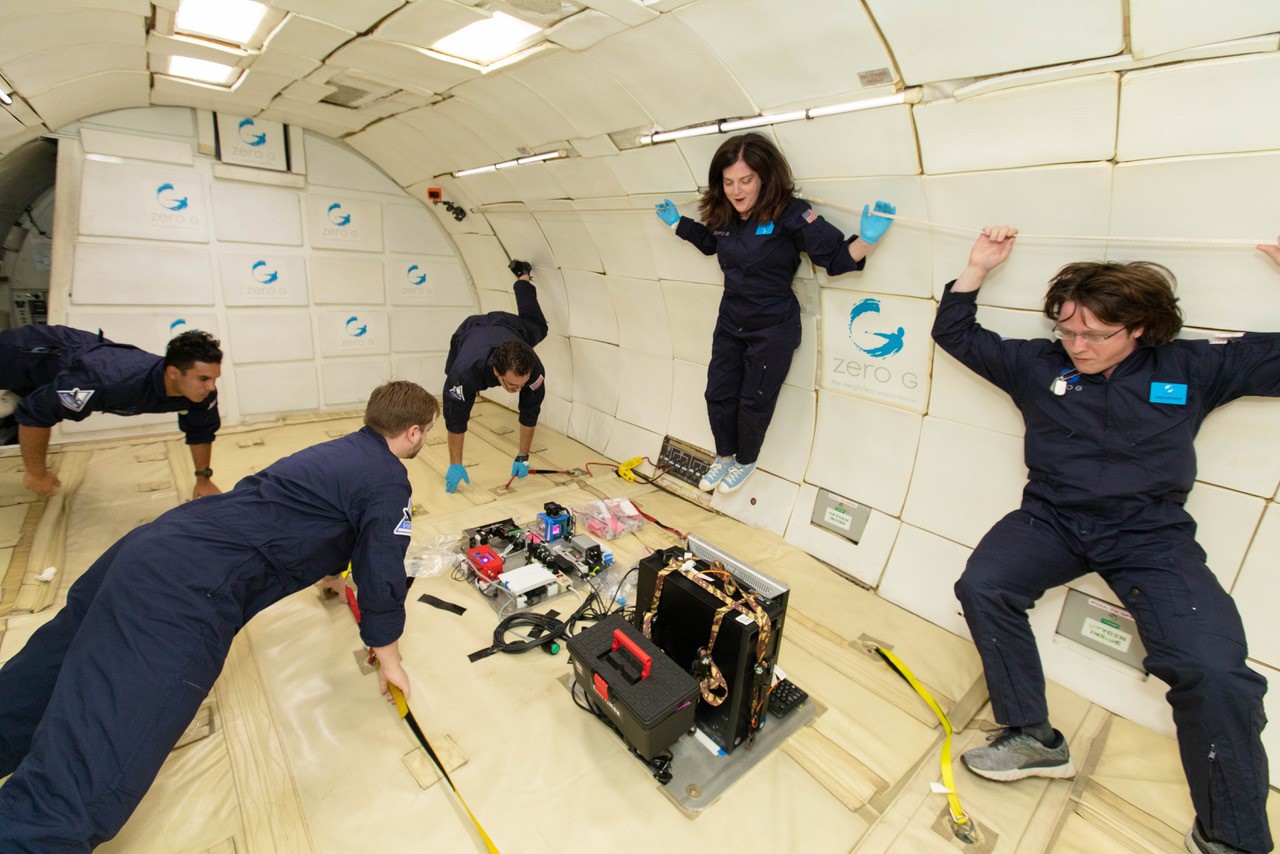No force – including gravity – could hold a team of NASA researchers down in their quest for a scientific breakthrough to benefit life on Earth and in space.
Scientists from NASA’s Marshall Space Flight Center in Huntsville, Alabama, completed two parabolic flights April 28 and 29 to test modifications to a payload called the ring-sheared drop.
“This demonstration proved that the modified hardware is capable of deploying and pinning each of the protein solutions that will be used in an experiment using the ring-sheared drop hardware on the International Space Station,” said Dr. Louise Strutzenberg, co-investigator on the ring-sheared drop parabolic re-flight experiment. “The lessons learned will prepare us to take the next steps before resuming testing on the space station.”
The team flew out of Fort Lauderdale, Florida, on Zero Gravity Corporation’s modified Boeing 727 aircraft, which achieves periods of variable gravity through a series of maneuvers called parabolas. The plane, called G-Force One, completed 30 parabolas each day – enabling the teams to tend to their experiment in weightlessness for 22-second intervals.
Developed by Marshall and Rensselaer Polytechnic Institute of Troy, New York, the experiment studies the formation of potentially destructive amyloid fibrils, or protein clusters, like those found in the brain tissue of patients battling neurodegenerative diseases – such as Alzheimer’s and Parkinson’s.
Such illnesses damage neurons, the drivers of the human nervous system, which chemically control information processing necessary for the mind and body to operate. The accumulation of these amyloid fibrils refuse to dissolve the way most proteins do. Instead, they build up over time until disrupting the healthy function of tissues and organs – which can be debilitating, or in some cases, fatal.
In Earth-based experiments, researchers determined that amyloid fibrils may be created by shear flow, or the difference of flow velocity between adjacent layers of a liquid. In grounded experimentation, that formation is affected by the shape of experiment containers and by heat convection – the tendency of hotter, less dense material to rise in fluid and colder, denser material to sink due to gravity.
However, conducting the experiment in microgravity eliminates heat convection and allows liquids to form in spherical drops, eliminating the need for a container. In these weightless conditions, researchers can “pin” a droplet of liquid between two rings and cultivate amyloid fibrils for study.
The ring-sheared drop payload initially launched to the International Space Station in 2019, but the hardware needed modifications to achieve the desired results. Since then, the Marshall team has been working to improve the efficacy of the experiment by making necessary adjustments before attempting more orbital deployments.
The team began with two parabolic flights in November, which allowed them to test several possible improvements to the payload. After flight, the team had approximately five months to implement lessons learned and prepare for the next flight opportunity in April.
In this April’s parabolic flight campaign, the test apparatus consisted of a syringe that holds solution to be dispensed, the newly modified cage-tip tube capable of dispensing a stable liquid drop, and a motor that is activated to drive the piston in the syringe to dispense the liquid. During flight, video cameras were in position to capture the behavior of the fluid droplet as it was dispensed.
“Being weightless is truly an indescribable experience,” Marshall materials science engineer Gabriel Demeneghi said. “It is even more exciting to be in microgravity to make strides on a project that you’re passionate about.”
On day one of flight, the team pinned two out of three protein solutions. Due to a power supply issue, the team’s high-speed camera was unable to capture the pinning. However, a back-up camera captured the majority of in-flight operations. Once their feet were firmly on the ground, the scientists were able to review video footage, correct the power supply, and modify operations to increase efficiency.
On the second day of flight, the team pinned one-inch drops of all four flight fluids – gathering all necessary footage and data to analyze on the ground. In addition, they successfully pinned one-inch drops of two pre-sheared test solutions that the Rensselaer Polytechnic Institute team prepared in pre-flight activities.
NASA’s Flight Opportunities program, within the Space Technology Mission Directorate, makes these experiment flights possible, facilitating rapid demonstration of promising technologies for space exploration, discovery, and results to benefit life on Earth.
The ring-sheared drop hardware is sponsored by NASA’s Biological and Physical Sciences, part of the agency’s Science Mission Directorate. The payload is scheduled to launch to the space station this summer from NASA’s Wallops Flight Facility in Virginia, on Northrop Grumman’s 16th Commercial Resupply Services mission.



























